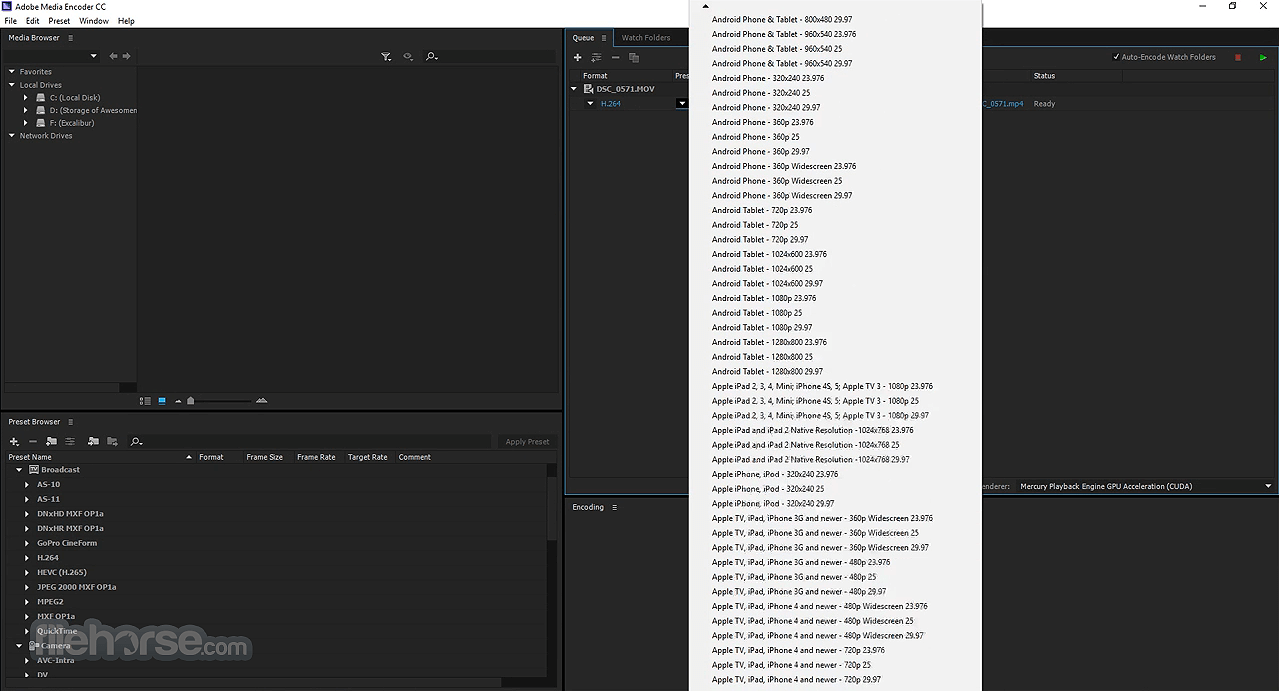

- 5DTORGB VS ADOBE MEDIA ENCODER FULL
- 5DTORGB VS ADOBE MEDIA ENCODER PRO
- 5DTORGB VS ADOBE MEDIA ENCODER WINDOWS
Or choose a preset from the Preset Browser and drag it to any item in the Queue. Encode the item using presets: Select formats and presets from the Format and Presets drop-down list with the item in the queue.For more information, see Import items into the encoding queue. Add an item to the encoding queue: Drag video or audio files into the queue panel in Adobe Media Encoder.You can perform the following actions using Adobe Media Encoder: Or you can tell the application to wait until you decide to start encoding. You can instruct the application to start encoding after you add an item to the queue. Select existing encoding presets or create your own custom settings. It's become a real swiss army knife for me.To encode a video or audio item, add the item to the encoding queue in Adobe Media Encoder. And another little project that required me to convert video to GIF. So I exported video once, then audio, then used fmpeg to losslessly mux the two streams. I can get SIGNIFICANTLY fewer artifacts if I export to DNxHR, and then use ffmpeg to convert to H.265 than if I export from Resolve as H.265.Īnd recently I did a job that asked for a specific codec for video and audio, the combination of which wasn't available to export straight out. I also use ffmpeg now to create H.265 files since Resolve's encoders are not very good. I've also had issues with reading metadata-sometimes VLC's media information seems off, but if I use ffprobe I can get a lot of details about a media file. I tried other converters but I had so many issues with not being able to preserve folder structure, not being able to control framerate, not being able to burn in the metadata I want, etc. After shooting I run a little python script that scans input folders and creates tiny 500 kb/s H.264 proxies with metadata burn in. I first started using ffmpeg to create proxies. No converter ever seems to have the options I'm looking for. Or do I just move toward Apple Compressor? Unfortunately it does not help for AME.ĭoes anyone have a working around to somehow export thousands of file using PPro in the same way as AME? Turning off the hardware-accelerated decoding option in PPro gets around the problem. Horrible process to so as to get back to the creative.
5DTORGB VS ADOBE MEDIA ENCODER FULL
I've wasted the past 5 weeks full time on this! No more! I've converted 8k mpeg2 files in hundreds of folders and am now moving towards tens of thousands of h.264 files. But this does not happen with the ProRes files also attached to the project.
5DTORGB VS ADOBE MEDIA ENCODER PRO
I'm in a huge fuckery where Premiere Pro CC 2019 keeps dropping linked media (mpeg2 and h.264) if/ when I reset preferences and/ or delete media cache. I am sure you probably have a good reason to do so. So I have to ask as to why you would be transcoding your h.264 files to ProRes in the first place. I am sure that many on this forum will attest to the fact that the stupidity of my questions knows no bounds. Apologies for the disruption.Īs most of you are aware by now, i am pretty much the king of stupid questions. I've filed the bug and asked our developers to investigate. Note that you need to restart After Effects after turning this option on or off, and you should purge the cache after the restart, otherwise previously cached frames from that footage will be used. The problem goes away when you disable the hardware-accelerated decoding option, which is enabled by default.

Premiere Pro also appears to be affected by the problem as well (same technology in Premiere Pro the hardware acceleration option is in Preferences > Media.) Note that the hardware acceleration option is only available on macOS 10.13 and later.
5DTORGB VS ADOBE MEDIA ENCODER WINDOWS
The same samples do not reproduce the problem in After Effects on Windows 10. I do not reproduce this problem with any other H.264 footage, just the Canon 5D samples that I have. In more concrete terms: a 1920x1080 frame renders vertically scaled (squished) to 1920x952, with the last 128 rows filled with black. The bottom 128 pixels of the footage are black, and the footage is vertically scaled so that it fits within the cropped dimensions. mov footage when hardware-accelerated H.264 decoding is enabled on Mac. It appears that After Effects 16.0 (and Premiere Pro 13.0) are mis-sizing Canon 5D H.264. Restart After Effects, then purge the cache via Edit > Purge > All Memory & Disk Cache. Disable the "Enable hardware accelerated decoding" option in Preferences > Import. The Headless Leader at Adobe strikes again. This place is a huge resource is a godsend to folks like me I'm way out on the bright side of nowhere here. In AME, I created an encoding Preset where I didn't select the "Match Source" tick box and instead set the Height & Width dimensions manually to 1920x1080.


 0 kommentar(er)
0 kommentar(er)
